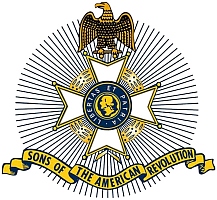Henry Bailey Greenwood Discovery Story
The path to discovering that Henry Bailey Greenwood was a "Patriot" supporting the American Revolutionary War commenced with the SAR (Sons of the American Revolution) Ceremony honoring Zachariah Landrum presented last fall in Montgomery, Texas.
PineyWoods SAR member Bob McKenna studied the history of the travels from Virginia to Texas of a group of families that included Zachariah Landrum. Members of this wagon train of "Austin Colonists" received permission from the then Mexican Government to settle in what is now Montgomery and Grimes Counties. The Montgomerys, Landrums, Shannons, and others had been readily identified as Patriots who had supported the American Revolution before traveling west after the war ended. Bob wondered how Henry Bailey Greenwood, who traveled with this group and intermarried with their families, had become associated with this group of colonists. It made sense that families who traveled together had common interests and backgrounds. Had Henry supported the American Revolution effort as the others had? This puzzle had to be researched.
Bob asked Kim Morton, our chapter genealogist, to study Henry’s early life. Kim researched the records of Botetourt County, Virginia, Henry's early home, and found that Henry had been a juror during the Revolutionary War Period. By contributing to the new legal authority in this way, Henry qualified as supporting the war effort and was therefore identified as a Patriot.
The question remained - why wasn't Henry identified as a Patriot by other researchers? It seems the answer is twofold. First, the gravestone of Henry in the Stoneham Cemetery, in Grimes County Texas, is engraved with a large anchor. Because of this symbol, his descendants erroneously concluded that Henry was a Sailor and not associated with the Revolutionary War. Further research showed that while an anchor on a tombstone could symbolize that the deceased was associated with the sea, it could also symbolize Hope. This second purpose is confirmed, in Henry’s case, by the inscription on the bottom of his stone which reads “In hope: Which hope we have as an anchor of the soul, both sure and stedfast, and which entereth into that within the veil.” (Hebrews 6:19)
Second, while researching his marriage records, it was found that Henry was a Quaker. Because of their religious beliefs, he would not have physically fought against any enemy. These two detractors certainly must have discouraged any further research into Henry’s qualification as a patriot until recently.
Although he would not have fought physically against an enemy, Henry’s service as a juror for the “legal authority” put him at considerable risk for harm as his action would be considered to be that of a traitor by the British. For this reason, jurist duty is considered to be qualifying support for the American Revolution by lineage based societies such as the SAR and DAR.
